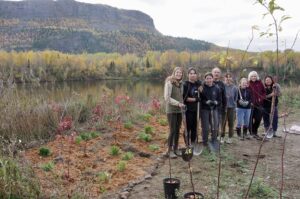Sweetgrass planted along the shoreline of the Kaministiquia River

By Rick Garrick
THUNDER BAY — Fort William’s Bobbi Bannon recently helped plant sweetgrass and some shrubs with volunteers along the shoreline of the Kaministiquia River on Oct. 16 at Thunder Bay’s Mountdale Boat Launch.
“So far, the process is going very well, we have a lot of wonderful volunteers that came out to help,” says Bannon, environmental officer at Fort William. “It was a tough go at first with the site, the way the soil was, but we managed to get probably most of the plants that we have, the 50 sweetgrass, in the ground. We have some red osier dogwood that we have planted, [we’re] starting on the pin cherry, it’s prepped well and it looks beautiful.”
Fort William received $40,000 in funding through the federal government’s Freshwater Action Plan to naturalize and stabilize shoreline habitat by planting trees and shrubs in the Grand Point and the Kaministiquia River areas.
“The erosion in the banks is creating a lot of runoff going into the river,” Bannon says. “And it helps stabilize the shoreline for natural habitation, for ecosystems and species to survive and thrive.”
Fort William Elder Myria Esquega says she smudged the whole area and the sweetgrass and shrubs before they were planted.
“The sweetgrass is one of our Anishinaabe medicines and it’s very important for our people to use,” Esquega says. “It’s very amazing that they’re doing this. It’s a very excellent spot to have the sweetgrass grow.”
Esquega says she has picked sweetgrass in a few different spots around the Fort William and Thunder Bay area.
“I just hope when it’s ready to be picked, that they don’t pull the roots out,” Esquega says, noting that sweetgrass should be cut about an inch above the ground during harvesting. “So it will keep growing and it will spread.”
Jessie McFadden, watershed biologist at the Lakehead Region Conservation Authority, says the planting site was an area of concern identified by Environment and Climate Change Canada.
“It’s been prioritized for some re-vegetation and restoration action,” McFadden says. “These sweetgrass plants will love the bank of the Kaministiquia River, they’re a water lover. The overall view at this site is to put some plants in the ground to help slow and filter runoff coming off the road in the spring and during rain events to take out some of the road salts and contaminants in that water before it enters the Kaministiquia River.”
The funding was part of $663,500 announced by Thunder Bay-Superior North MP Patty Hajdu on Oct. 10 for six projects that will support region-specific actions to restore water quality and ecosystem health in the Fort William and Thunder Bay area.
“People in northwestern Ontario have a deep appreciation for the waterways that nourish our region, including Lake Superior,” Hajdu says. “Our ways of life are intertwined with water, as are the animals and land. Increasingly, water is under attack through pollution and other changes that cause great damage to the water and wildlife we hold dear. With these federal investments, organizations will have support to continue their hard work on behalf of all of us to restore, rehabilitate, and protect the water systems in our region.”
The six projects were among 24 new projects, funded through an investment of more than $2.7 million over three years, that were announced on Sept. 28 to restore water quality and ecosystem health in the Great Lakes Areas of Concern, prevent toxic and nuisance algae and engage Indigenous peoples in Great Lakes restoration and protection.


